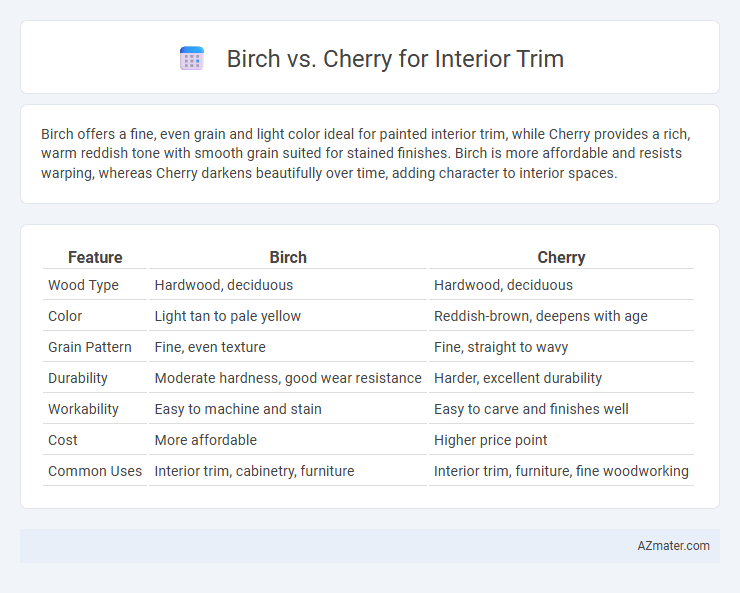Birch offers a fine, even grain and light color ideal for painted interior trim, while Cherry provides a rich, warm reddish tone with smooth grain suited for stained finishes. Birch is more affordable and resists warping, whereas Cherry darkens beautifully over time, adding character to interior spaces.
Table of Comparison
| Feature | Birch | Cherry |
|---|---|---|
| Wood Type | Hardwood, deciduous | Hardwood, deciduous |
| Color | Light tan to pale yellow | Reddish-brown, deepens with age |
| Grain Pattern | Fine, even texture | Fine, straight to wavy |
| Durability | Moderate hardness, good wear resistance | Harder, excellent durability |
| Workability | Easy to machine and stain | Easy to carve and finishes well |
| Cost | More affordable | Higher price point |
| Common Uses | Interior trim, cabinetry, furniture | Interior trim, furniture, fine woodworking |
Introduction to Birch and Cherry Wood
Birch wood is known for its fine, even grain and pale color, making it a popular choice for interior trim that requires a smooth, uniform appearance. Cherry wood offers a rich, warm reddish-brown hue that deepens with age, adding elegance and character to interior trim applications. Both woods provide durability and workability, but cherry's natural luster and color variation create a more distinctive, luxurious finish compared to birch.
Overview of Interior Trim Applications
Birch and cherry are popular choices for interior trim due to their durability and aesthetic appeal, with birch offering a lighter, consistent grain that works well in modern or minimalist designs and cherry providing a rich, warm tone that deepens over time, enhancing traditional or elegant spaces. Birch's tight grain and pale color make it ideal for paint-grade applications and contemporary interiors, whereas cherry's fine grain and reddish hues suit staining and high-end finishes in classic or luxury homes. Both woods resist wear and are suitable for baseboards, crown molding, window casings, and door frames, making them versatile for various interior trim applications.
Birch Wood: Key Characteristics
Birch wood is highly valued for interior trim due to its fine, uniform texture and light color, which easily accepts stains to achieve various finishes. Its durability and resistance to wear make it ideal for high-traffic areas, while its smooth grain provides a clean, modern aesthetic. Compared to cherry, birch is more affordable and offers greater flexibility in design due to its neutral tone.
Cherry Wood: Key Characteristics
Cherry wood boasts a rich, warm reddish-brown hue that deepens with age, making it highly sought after for interior trim in upscale homes. Its fine, straight grain and smooth texture offer a refined finish that enhances detailed craftsmanship and molding work. Known for its durability and resistance to warping, cherry wood provides a long-lasting, elegant solution for baseboards, crown molding, and door casings.
Color and Grain Differences
Birch interior trim features a pale, creamy color with a subtle reddish hue that brightens spaces, while cherry wood presents a rich, warm reddish-brown tone that deepens and darkens over time. Birch grain is generally straight and fine with occasional curls or waves, creating a smooth, uniform texture, whereas cherry grain exhibits a more pronounced, flowing pattern with natural swirls and occasional small knots. The visual contrast between birch's light, consistent appearance and cherry's warm, dynamic texture makes each wood type appealing for distinct interior design styles.
Durability and Hardness Comparison
Birch wood exhibits moderate durability and hardness with a Janka hardness rating around 1260, making it suitable for interior trim with good resistance to dents and wear. Cherry wood, with a Janka hardness of approximately 950, is softer but offers excellent workability and develops a rich patina over time, enhancing its aesthetic appeal despite being less durable than birch. Choosing between birch and cherry for interior trim depends on balancing durability needs and the desire for a warm, evolving finish.
Workability and Ease of Installation
Birch offers superior workability for interior trim due to its fine, even grain and consistent hardness, allowing for smooth cuts and detailed shaping with minimal splintering. Cherry, while slightly harder, machines well but may require sharper tools to prevent burn marks and ensure clean edges during installation. Both woods provide stability, but birch is often preferred by carpenters for quicker, more precise fitting, reducing installation time and effort.
Cost and Availability
Birch is generally more affordable and widely available than cherry, making it a popular choice for interior trim on a budget. Cherry wood tends to be pricier due to its rich color and fine grain, with availability often limited to specialty lumber suppliers. Choosing birch offers cost savings and easier sourcing without significantly sacrificing durability or appearance.
Design Compatibility and Aesthetics
Birch offers a light, uniform grain that complements modern and minimalist interior trim designs, creating a clean, bright aesthetic ideal for Scandinavian or contemporary styles. Cherry wood provides rich, warm tones with a distinctive grain pattern, enhancing traditional, classic, or rustic interiors by adding depth and elegance. Both woods offer durability, but Birch excels in versatility and neutrality while Cherry stands out for its luxurious, timeless appeal.
Which Wood is Best for Your Interior Trim?
Birch offers a smooth, light-colored grain that accepts paint and stain exceptionally well, making it ideal for versatile interior trim designs. Cherry provides rich, warm tones with a natural luster that deepens over time, creating an elegant, classic look perfect for premium trims. Birch is best for budget-friendly projects requiring durable workability, while cherry suits high-end interiors prioritizing luxury and timeless appeal.

Infographic: Birch vs Cherry for Interior Trim
 azmater.com
azmater.com